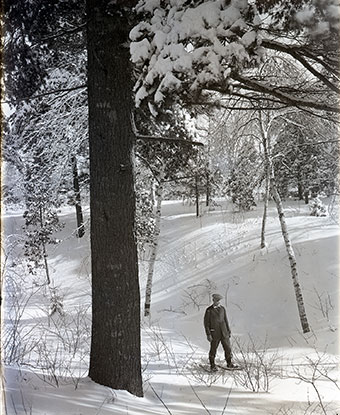Last updated: February 24, 2022
Person
George B Dorr

NPS Archives
George Bucknam Dorr, (December 29, 1853-August 5, 1944) known as the father of Acadia National Park, spent most of his adult life bringing the park into being, caring for the park, and expanding it.
History
Dorr was a private citizen whose life covered the last half of the 1800s and the first half of the 1900s. He came from privilege, the son of affluent Bostonians. He inherited fortunes from both his parents and traveled widely in Europe with his parents. He was a gentleman scholar and Harvard University graduate. Dorr was a lover of nature who first visited Mount Desert Island in 1868 on a vacation with his parents and made the decision to make the island his primary home. The remains of the family residence, Old Farm, at Compass Harbor in Bar Harbor, are part of Acadia National Park today. He never married; instead he focused his time, energy, and intellect on preserving the natural beauty of his beloved island.
Over four decades he worked tirelessly to acquire tracts of land for protection, build trails, and lay plans as a member of both civic groups that founded Acadia National Park.. He donated scores of parcels of his own land and persuaded others to donate land or gift funds. It was Dorr’s vision and passion that ensured lands would be set aside for preservation and protection for future generations.
Collecting Land
This project was never easy or straightforward. Challenges were frequent. In early 1913 while at home in Boston, hoping to enjoy a peaceful winter social season there, he received word that some in the Maine state legislature were determined to revoke the nonprofit status of the Hancock County Trustees for Public Reservations (one of the civic groups who helped found Acadia). He immediately set out for Augusta, Maine, and spent days successfully fighting the measure. He realized at that time, however, that the lands he’d fought so hard to acquire needed the greater protection of the federal government, and he began a new drive to secure that protection. Soon he was on his way to Washington, meeting with powerful and influential friends there. He would make many trips armed with maps and deeds and titles; he would provide more and more information to the federal bureaucracy and deal with political stumbling blocks. Finally in 1916, President Woodrow Wilson created Sieur de Monts National Monument. This process had taken more than two years, but with great persistence, and the help of influential friends, Dorr made it happen. While the Trustees would have preferred national park status, Dorr chose to have Wilson sign off on the national monument rather than waiting for Congress to act on the national park. With the establishment of the National Park Service in 1916, Acadia was in line for designation as a national park. It was not until 1919 that Lafayette National Park came into being.
George Dorr built the spring house at Sieur de Monts in 1909 and carved “The Sweet Waters of Acadia” on a nearby rock. Today, this location has come to symbolize the enthusiasm and contributions of Dorr and other early-20th-century citizens in the creation and preservation of these lands. Dorr was ever vigilant that anything done in the park would be of the highest quality and not mar the incredible beauty and uniqueness of the area. In 1913, John D. Rockefeller Jr. began construction of a carriage road system on private land that was developed and expanded as public land with Dorr’s support.
Later Life
His later years would certainly bring satisfaction but also trials and difficulties. He loved to hike and walked all over the island. He swam in Frenchman Bay almost daily, even having to break ice along the edges to do so. He had a heart attack in 1934 while enjoying his morning swim and was told he had six months to live (he lived ten more years). Chronic visual difficulties recurred throughout his life until he lost his sight in his final years.
Dorr always believed his personal fortune could absorb purchasing land on behalf of the park forever, but this was not the case. At the onset, he declined any salary except for one dollar a month as the first custodian of the national monument, but by the time the park became Acadia in 1929, he gladly accepted a regular salary. Despite the income from his highly successful Mount Desert Nurseries, he depleted his inheritance in the decade prior to the inauguration of Franklin Delano Roosevelt. The federally funded social programs of the President enabled the park to rapidly develop in ways that eclipsed what had been accomplished in the first decade of the park.
Dorr’s Old Farm estate was accepted a park property one month before the attack on Pearl Harbor. The park superintendent never retired and continued working with Mr. Rockefeller on land aquisition projects until August 5, 1944 when the heart that was supposed to have given out ten years earlier finaly stopped. The National Park Service and the executors of his estate renamed the mountain overshadowing Sieur de Monts Spring and a mounument at the base of Dorr Mountain honors his memory.
Saved to future generations as it has been to us, in the wild primeval beauty of the nature it exhibits, of ancient rocks and still more ancient sea, with infinite detail of life and landscape interest between, the spirit and mind of man will surely find in it in the years and centuries to come an inspiration and a means of growth as essential to them ever and anon as are fresh air and sunshine to the body.
- George B. Dorr
